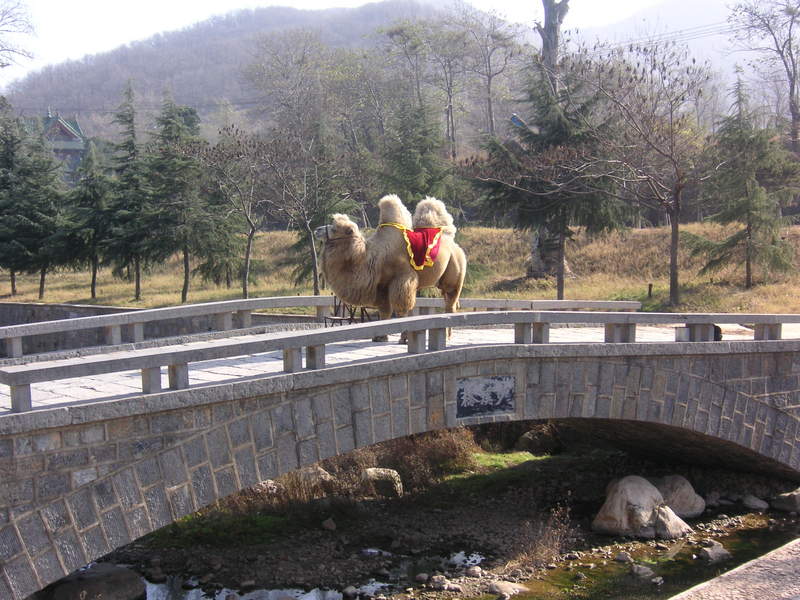雙峰駱駝 雙峰駱駝(學名Camelus bactrianus),也叫雙峰駝,是駱駝的一種,與單峰駱駝不同,有雙峰,主要棲息在中亞。
今天全世界大約有一百四十萬頭雙峰駱駝,但幾乎全部是馴養品種。2002年10月數據顯示,在中國西北和蒙古大約還有950頭野生雙峰駝,世界自然保護聯盟(IUCN)已將該物種列為極度瀕危。
雙峰駱駝的身高超過2米(最高點駝峰的高度),體重超過725公斤。主要以草、樹葉和穀物為食,一次最多可以喝下120升的水,其身體特徵非常適應于乾燥炎熱的沙漠氣候。
根據歷史資料,古代人類可能在公元前25世紀就已經開始馴養雙峰駱駝[1],最初馴養雙峰駱駝的地區是今天伊朗的北部、阿富汗的東北部,以及巴基斯坦北部地區。
The Bactrian Camel (Camelus bactrianus) is a large even-toed ungulate native to the steppes of north eastern Asia. It is one of the two surviving species of camel. The Bactrian Camel has two humps on its back, in contrast to the single-humped Dromedary Camel.[1]
Nearly all of the estimated 1.4 million Bactrian Camels alive today are domesticated, but in October 2002 the estimated 950 remaining in the wild in northwest China and Mongolia were placed on the critically endangered species list.[2]
It is thought that the Bactrian Camel was domesticated (independently from the dromedary) sometime before 2500 BC,[3] probably in northern Iran, Northeast Afghanistan,[3] or southwestern Turkestan.[4] The dromedary is believed to have been domesticated between 4000 BCE and 2000 BCE[5] in Arabia. The wild population of Bactrian Camels was first described by Nikolai Przhevalsky in the late 19th century.
Bactrian Camels have been the focus of artwork throughout history. For example, western foreigners from the Tarim Basin and elsewhere were depicted in numerous ceramic figurines of the Chinese Tang Dynasty (618–907).
There is some evidence that the Bactrian Camel can be divided up into different subspecies. In particular, it has been discovered that a population of wild Bactrian Camel lives within a part of the Gashun Gobi region of the Gobi Desert. This population is distinct from domesticated herds both in genetic makeup and in behavior.
There are possibly as many as three regions in the genetic makeup that are distinctly different from domesticated camels and there is up to a 3% difference in the base genetic code. However, with so few wild camels, it is unclear what the natural genetic diversity within a population would have been.
Canadian researcher William Sommers found that these wild camels had the ability to drink saltwater slush, although it is not yet certain the camel can extract useful water from it. Domesticated camels do not attempt to drink salt water, though the reason is unknown.
The Bactrian Camel was identified as one of the top-10 "focal species" in 2007 by the Evolutionarily Distinct and Globally Endangered (EDGE) project.[6] EDGE identifies species that are evolutionarily distinct and need better protection to prevent extinction. The Bactrian Camel was placed in the top-10 along with Golden-rumped Elephant Shrew, Sir David's Long-beaked Echidna, Hispaniolan Solenodon, Yangtze River dolphin, Slender loris, Hirola, Pygmy Hippo, Bumblebee bat, and the Long-eared Jerboa.[7] There are only hundreds of them in the wild and the population is decreasing, but a large captive population has been kept.
쌍봉낙타(Camelus bactrianus)는 북동아시아의 초원에 서식하는 낙타이다. 이름과 같이 쌍봉낙타는 단봉낙타와 달리 두개의 혹이 있다. 단봉낙타보다 튼튼하며 사지는 굵고 짧다. 육봉의 혹이 두 개이며 털은 길고 뻑뻑하다. 발바닥은 단단하여 바위나 자갈이 많은 구릉지에 적합하다. 옛날부터 아프가니스탄·고비 사막·중국 등지에서 사육되었으며 반야생상태의 것도 있다. 새끼는 날 때부터 눈을 뜨고, 몸은 양털 같은 털로 덮여 있다. 태어난 지 몇 시간이 지나면 달릴 수 있고, 새끼와 어미는 떼어 놓지 않는 한 몇 년이고 함께 지낸다.
현존하는 1백 4십만마리의 대부분은 가축화된 상황이며, 북동중국과 몽골에 남아있는 야생개체는 950마리 밖에 남지 않아 존치상태 가 위급한 것으로 평가되었다.[1]
フタコブラクダ(二瘤駱駝)は、哺乳綱偶蹄目ラクダ科ラクダ属に分類されるラクダのうち「瘤」が2つあるもの。
家畜種 Camelus bactrianus と野生種 Camelus ferus からなるが、同種の亜種とされることもある。
家畜種の種小名bactrianusは「バクトリアの」の意で、中央アジアにかつて存在した王国の名に由来する。英名も同義。
野生の個体(推定約950頭)は中国北西部とモンゴルに生息する。家畜化された個体(推定約140万頭)はより広い地域に分布している。
体長220-350cm。体高(地上から瘤までの高さ)190-230cm。体重300-650kg。野生個体より家畜化された個体の方が大型になる。和名の通り背中に2つの脂肪の塊(瘤)がある。ラクダ属のヒトコブラクダと比べると体は頑丈で四肢が短い。
砂漠や草原に生息する。
食性は植物食で、草等を食べる。
繁殖形態は胎生で、1回に1頭の幼獣を出産する。妊娠期間は13ヶ月程。
紀元前2000年頃には既に家畜化されていたとされる。現存する野生個体も一度家畜化された個体が逃げ出し、野生化した個体とする説もある。
移動手段、荷物の運搬に利用される他、毛皮、乳、肉、糞(燃料として)が人間に利用される。
